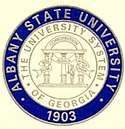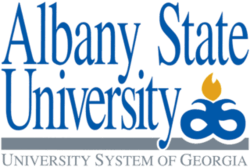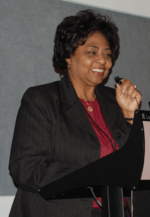Albany State University
 | |
| Motto | A Past To Cherish, A Future To Fulfill |
|---|---|
| Type | Public, HBCU[1] |
| Established | 1903 |
| Affiliation | University System of Georgia |
| Endowment | $1.8 million[2] |
| President | Marion Fedrick (Interim President)[3] |
| Students | 6,615 (fall 2017) |
| Location | Albany, Georgia, U.S. |
| Campus | Urban, 231-acre (934,823.8 m2) |
| Colors |
Royal blue and Old gold |
| Athletics | NCAA Division II |
| Nickname | Golden Rams |
| Affiliations | SIAC |
| Website |
www |
 | |
Albany State University is a four-year, state-supported, historically black university (HBCU) located in Albany, Georgia, United States. It is the largest of three HBCUs in the University System of Georgia. ASU is a member-school of the Thurgood Marshall College Fund.
History
| 1903 | Established as the Albany Bible and Manual Training Institute |
| 1917 | Became a state-supported, two year, agricultural and teacher training college and renamed to The Georgia Normal and Agricultural College |
| 1932 | Became a part of the University System of Georgia |
| 1943 | Granted four-year status and renamed to Albany State College |
| 1981 | First graduate program established |
| 1996 | Name changed to Albany State University. |
| 2017 | Albany State University, Darton State College became one consolidated University. |
Establishment
Joseph Winthrop Holley, born in 1874 to former slaves in Winnsboro, South Carolina, founded the institution in 1903 as the Albany Bible and Manual Training Institute. Two educators, Reverend Samuel Loomis and his wife, sent Holley to Brainerd Institute and then Revere Lay College (Massachusetts). When attending Revere Lay, Holley got to know one of the school's trustees, New England businessman Rowland Hazard. After taking a liking to Holley, Hazard arranged for him to continue his education at Phillips Academy in Andover, Massachusetts. Holley aspired to become a minister and prepared by completing his education at Pennsylvania's Lincoln University.
W. E. B. Du Bois inspired Holley to return to the South after he read Du Bois's writings on the plight of Albany's blacks in The Souls of Black Folk. Holley relocated to Albany to start a school. With the help of a $2,600 gift from the Hazard family, Holley organized a board of trustees and purchased 50 acres (200,000 m2) of land for the campus, all within a year. The aim of the institution at the time was to provide elementary education and teacher training for the local Black population. It was turned over to the state of Georgia in 1917 as Georgia Normal and Agricultural College, a two-year agricultural and teacher-training institution.[4]
In 1932, the school became part of the University System of Georgia and in 1943 it was granted four-year status and renamed Albany State College. The transition to four-year status heavily increased the school's enrollment. In 1981 the college offered its first graduate program, a prelude to the school being upgraded to university status in 1996.
Holley served as President of the school from 1903–1943. He was succeeded by Aaron Brown (1943–1954), William Dennis (1954–1965), Thomas Miller Jenkins (1965–1969), Charles Hayes (1969–1980), Billy C. Black (1980–1996), Portia Holmes Shields (1996–2005), Everette J. Freeman (2005 – 2013) Art Dunning (2015-2018) and Marion Fredrick (2018-)
Civil Rights Movement
The college played a significant role in the Civil Rights Movement in the early 1960s. Many students from the school, Black improvement organizations, and representatives from the Student Nonviolent Coordinating Committee (SNCC) came together to create the Albany Movement. The movement brought prominent civil rights leaders to the town including Martin Luther King Jr. The movement resulted in the arrests of more than 1,000 black protestors. Among the very first to be arrested were students from Albany State. On November 22, 1961, Blanton Hall and Bertha Gober entered the white waiting room of the Albany bus station to buy tickets home for the Thanksgiving holiday. Refusing to leave after being ordered to do so, police arrested them both. Albany State President William Dennis, fearful of losing his position, immediately suspended and eventually expelled the students. This action engendered a great deal of animosity from the black community and the student body. Gober would continue in the civil rights movement as one of the SNCC's Freedom Singers and write the group's anthem. Bernice Johnson Reagon, another Albany State student who left school to work with the SNCC, would later form the well-known a cappella group Sweet Honey in the Rock. On December 10, 2011, thirty two of the students who were expelled were granted honorary degrees. The school awarded thirty one honorary baccalaureate degrees and one honorary doctorate – that to Bernice Johnson Reagon. A noted cultural historian, Reagon was also the commencement speaker.[5]
Albany State University
In July 1996 the university system's Board of Regents approved the two schools to merge, and the school officially became Albany State University. Today Albany State University continues to provide a wide range of educational opportunities to the residents of southwest Georgia. The school participates in an engineering transfer program and a dual degree program with the Georgia Institute of Technology, one of the top engineering schools in the nation. Then President, Portia Shields created the Holley Institute summer program, which consists of an intense four weeks of study to help high school students improve low SAT scores and gain admission to college. The program has a near 100 percent success rate and has received praise from the state Board of Regents. Albany State also has the third highest student retention rate in the university system. A new stadium was opened in 2004, and new housing units opened in 2006. In 2015, the Board of Regents of the University System of Georgia announced the consolidation of ASU and Darton State College. The new combined institutions will assume the name and branding of Albany State University, and was expected to enroll around 9,000 students. However, the combining of the two institutions has greatly decreased the combined enrollment. Fall 2013 enrollments were 6,195 for Darton State College and 4,260 for Albany State University.[6] Whereas Fall 2017 enrollments for the new combined Albany State University is 6,615.[7] This represents a 27% decrease over that period.
Due to the Darton State merge, Albany State has become the largest HBCU in the state of Georgia and one of the largest in the United States.[8]
Academics
Albany State offers undergraduate and graduate liberal arts and professional degree programs.
According to U.S. News & World Report, ASU is ranked 27th in the magazine's ranking of undergraduate education at HBCUs and[9] is ranked as the 106th school on the Regional Universities (South) list.[10] The student-faculty ratio is 19:1 and over half of the classes contain less than 20 students. The most popular majors are: business, marketing, management, education, law enforcement and health professions. The average retention rate is 71 percent.
Colleges
The Graduate school degree programs include: Business Administration, Criminal Justice, Early Childhood Education, Educational Leadership(M.Ed&Ed.S), English Education, Health and Physical Education, Mathematics Education, Middle Grades Education, Music Education, Nursing, Public Administration, School Counseling, Science Education, and Special Education.[12]
Our five colleges offer 13 certificates, 14 associate, 30 baccalaureate, and 12 graduate degrees. The university also offers the Board of Regents' engineering transfer program and the dual degree program in engineering with Georgia Tech. Today, Albany State University provides innovative instructional and professional programs through its five academic colleges: Arts and Humanities, Sciences and Technology, Business, Education, the Darton College of Health Professions, and the Graduate School. The University serves 24 counties in the Southwest Georgia area with graduate and undergraduate courses in more than 30 fields.
Campuses
*Albany State University East campus (Main) 504 College Drive, Albany, Georgia 31705
is located on 206 acres East of the Flint River that has 32 buildings and 5 sport facilities
- Albany State University West campus (formerly Darton State College) 2400 Gillionville Rd. Albany, Georgia 31707
is located on 186 acres in West Albany, GA and has 16 buildings and 5 sport facilitites
additionally, ASU has a center in Cordele, Georgia, and holds specific courses at other sites in Cairo, Waycross, Thomasville, Swainsboro, and Sandersonville, Georgia.
Demographics
Today the Albany State University student body consists of both traditional and non-traditional students who make up nearly 7,000 students on campus. These students come primarily from Atlanta, Southwest and Central Georgia, other US states and many foreign countries. The average student age is 24 and about 40 percent of the students live in on-campus housing.[13]
Student life
Student organizations
There are over 59 clubs and organizations including bands, choirs, religious groups, honor societies, several major Greek and honor sororities and fraternities, and ROTC.
Fraternities and sororities
All nine of the National Pan-Hellenic Council organizations currently have chapters at Albany State University. These organizations are:
| Organization | Symbol | Chapter | Chapter Symbol |
|---|---|---|---|
| Alpha Kappa Alpha | ΑΚΑ | Gamma Sigma | ΓΣ |
| Alpha Phi Alpha | ΑΦΑ | Delta Delta | ΔΔ |
| Delta Sigma Theta | ΔΣΘ | Delta Rho | ΔΡ |
| Iota Phi Theta | ΙΦΘ | Zeta Pi | ΖΠ |
| Kappa Alpha Psi | ΚΑΨ | Delta Xi | ΔΞ |
| Omega Psi Phi | ΩΨΦ | Chi Epsilon | ΧΕ |
| Phi Beta Sigma | ΦΒΣ | Beta Psi | ΒΨ |
| Sigma Gamma Rho | ΣΓΡ | Zeta Psi | ΖΨ |
| Zeta Phi Beta | ΖΦΒ | Pi Beta | ΠΒ |
Service Fraternity and Sorority
There are currently two national service fraternity and sorority at Albany State University. These organizations are:
| Organization | Symbol | Chapter | Chapter Symbol |
|---|---|---|---|
| Alpha Phi Omega | ΑΦΩ | Psi Sigma | ΨΣ |
| Gamma Sigma Sigma | ΓΣΣ | Epsilon Omicron | ΕΟ |
Music organizations
Two of the music organizations currently have chapters at Albany State University. These organizations are:
| Organization | Symbol | Chapter | Chapter Symbol |
|---|---|---|---|
| Phi Mu Alpha Sinfonia | ΦΜΑ | Rho Delta | ΡΔ |
| Kappa Kappa Psi | ΚΚΨ | Eta Kappa | ΗΚ |
Marching Rams Show Band
Albany State's marching band participated in the 2007, 2008, 2010, 2011, 2012, 2013 and 2014 Honda Battle of the Bands (HBOB). The Marching Rams Show Band participated in the 2016 Tournament of Roses Parade and Tournament of Roses Bandfest .
Athletics
Albany State University holds membership in NCAA Division II (as a member of the Southern Intercollegiate Athletic Conference) and participates in the following sports: football, basketball, baseball, golf, cheerleading, volleyball, cross-country and track and field.[14] Additionally, ASU's women soccer team competes in the NJCAA.[15] Russell Athletic is the current sponsor of the Albany State University Athletic Department.
Swimming
Albany State sponsored men's and women's swimming and diving teams in past years and were named National Black College Swimming and Diving Champions in 1979 and 1980.
Notable alumni
This is a list of notable alumni which includes graduates, non-graduate former students, and current students of Albany State University. It also reflects those alumni who attended and/or graduated from the institution under its prior historical names.
{{alum/start
|ilist=

| class="note" | first African-American woman to win an Olympic gold medal and the only American woman to win a gold medal in the 1948
| style="text-align:center;" | [16] |- style="vertical-align:top;" class="vcard" | class="fn" | Walter Curry | style="text-align:center;" |
| class="note" | former professional football player
| style="text-align:center;" | |- style="vertical-align:top;" class="vcard" | class="fn" | Kenneth Gant | style="text-align:center;" |
| class="note" | former professional football player
| style="text-align:center;" | [17] |- style="vertical-align:top;" class="vcard" | class="fn" | Dr. Shaun Harper | style="text-align:center;" | 1998
| class="note" | author and leading scholar on racial equality in higher education-Professor, Founder, and Executive Director of the Center for the Study of Race and Equality in Education, University of Pennsylvania
| style="text-align:center;" | [18] |- style="vertical-align:top;" class="vcard" | class="fn" | Big James Henderson | style="text-align:center;" | 1984–1986
| class="note" | former powerlifter who competed in the International Powerlifting Federation and won five world bench press titles. Offensive Lineman for the 1985 SIAC Conference Championship football team.
| style="text-align:center;" | [19] |- style="vertical-align:top;" class="vcard" | class="fn" | Art Green | style="text-align:center;" |
| class="note" | former CFL and NFL player
| style="text-align:center;" | [20] |- style="vertical-align:top;" class="vcard" | class="fn" | James Holmes | style="text-align:center;" | 1968
| class="note" | first African American Director of the U.S. Census Bureau
| style="text-align:center;" | [21] |- style="vertical-align:top;" class="vcard" | class="fn" | Caldwell Jones | style="text-align:center;" |
| class="note" | former professional basketball player
| style="text-align:center;" | [22] |- style="vertical-align:top;" class="vcard" | class="fn" | Charles Jones | style="text-align:center;" |
| class="note" | former professional basketball player
| style="text-align:center;" | [23] |- style="vertical-align:top;" class="vcard" | class="fn" | Major Jones | style="text-align:center;" |
| class="note" | former professional basketball player
| style="text-align:center;" | [24] |- style="vertical-align:top;" class="vcard" | class="fn" | Wil Jones | style="text-align:center;" |
| class="note" | former professional basketball player
| style="text-align:center;" | [24] |- style="vertical-align:top;" class="vcard" | class="fn" | Dan Land | style="text-align:center;" |
| class="note" | former professional football player
| style="text-align:center;" | [17] |- style="vertical-align:top;" class="vcard" | class="fn" | Jo Marie Payton | style="text-align:center;" |
| class="note" | actress
| style="text-align:center;" | [25] |- style="vertical-align:top;" class="vcard" | class="fn" | Bernice Johnson Reagon | style="text-align:center;" |
| class="note" | singer, composer, scholar, and social activist; Professor Emeritus of History at American University in Washington, DC; Curator Emeritus at the Smithsonian Institution’s National Museum of American History in Washington, DC; 2002–04 Cosby Chair Professor of Fine Arts at Spelman College in Atlanta Georgia
| style="text-align:center;" | [26] |- style="vertical-align:top;" class="vcard" | class="fn" | Shirley Sherrod | style="text-align:center;" | 1970
| class="note" | civil rights advocate, former Georgia State Director of Rural Development for the United States Department of Agriculture
| style="text-align:center;" | [27] |- style="vertical-align:top;" class="vcard" | class="fn" | Rick Ross | style="text-align:center;" | played football for two years
| class="note" | rapper
| style="text-align:center;" |
|- style="vertical-align:top;" class="vcard" | class="fn" | A. Zachary Faison Jr., Esq. | style="text-align:center;" | 2002
| class="note" | Attorney, Educator, Nation's Youngest President of a Historically Black College or University; President & CEO at Edward Waters College in Jacksonville, FL; ref=[28]}}ref=[29]
| |- | Mike White | | former professional football player and former head football coach at Albany State University | }}
References
- ↑ "List of HBCUs – White House Initiative on Historically Black Colleges and Universities". August 16, 2007. Archived from the original on December 23, 2007. Retrieved January 3, 2008.
- ↑ Albany State University | Best College | US News. Colleges.usnews.rankingsandreviews.com. Retrieved on 2013-08-09.
- ↑ https://www.asurams.edu/marion-fedrick-named-interim-president-albany-state-university/
- ↑ "Albany State University". The New Georgia Encyclopedia. Retrieved 2008-01-23.
- ↑ Lewis, Terry (December 8, 2011). "Expelled students to get degrees". Albany Herald. Retrieved February 5, 2012.
- ↑ http://www.usg.edu/assets/research/documents/enrollment_reports/SER_Fall_2013_Final.pdf
- ↑ http://www.usg.edu/assets/usg/docs/news_files/BOR_USG_Fall_2017_Enrollment_Report.pdf
- ↑ "Abany State at a Glance".
- ↑ "Historically Black Colleges and Universities". 2018. Archived from the original on 2017-02-25. Retrieved 27 August 2018.
- ↑ "Albany State University". Archived from the original on 2017-03-22. Retrieved 27 August 2018.
- 1 2 3 4 "Albany State University". Albany State University. Archived from the original on February 10, 2008. Retrieved 2008-02-06.
- ↑ "Summary of Supporting Application Materials Required for Degrees" (PDF). Albany State University. Archived from the original (PDF) on 2008-04-14. Retrieved 2008-02-06.
- ↑ "Albany State University". Board of Regents of the University System of Georgia. Archived from the original on 2008-01-02. Retrieved 2008-02-07.
- ↑ "Albany State Athletics Overview". Albany State University. Retrieved 2018-01-17.
- ↑ "Lady Rams sign seven players for women's soccer". Albany State University. Retrieved 2018-03-26.
- ↑ "Biography of Alice Coachman". Archived from the original on February 2, 2011.
- 1 2 "NFL Players who attended Albany State University". databaseSports.com. Archived from the original on March 7, 2008. Retrieved 2008-02-06.
- ↑ http://www.gse.upenn.edu/equity/content/researchers-and-staff. Missing or empty
|title=(help) - ↑ "Big James Henderson Bio". Retrieved January 1, 2009.
- ↑ "Art Green". Retrieved 2012-05-09.
- ↑ "Census 1998 – 2000 Archives". Archived from the original on May 22, 2010. Retrieved May 22, 2010.
- ↑ "Caldwell Jones". Basketball-reference.com. Archived from the original on May 17, 2008. Retrieved 2008-05-21.
- ↑ "Charles Jones". Archived from the original on May 23, 2008. Retrieved 2008-05-21.
- 1 2 "NBA/ABA Players who attended Albany State University". Basketballreference.com. databaseSports.com. Archived from the original on February 21, 2008. Retrieved 2008-02-06.
- ↑ "Albany Map Population Information and City Statistics". juggle.com. Archived from the original on July 17, 2011. Retrieved January 21, 2011.
- ↑ "Bernice Johnson Reagon:Scholarship:2006 bio statement". bernicejohnsonreagon.com. songtalk publishing. Archived from the original on March 3, 2008. Retrieved February 7, 2008.
- ↑ "Sherrod encourages grads to end racism". Archived from the original on 2011-07-18. Retrieved 2010-12-30.
- ↑ stude
- ↑ </ref>
Suggested reading
- Brown, Titus. Albany State University : a centennial history, 1903–2003. Charleston, SC: Arcadia Pub. ISBN 0-7385-1493-4.